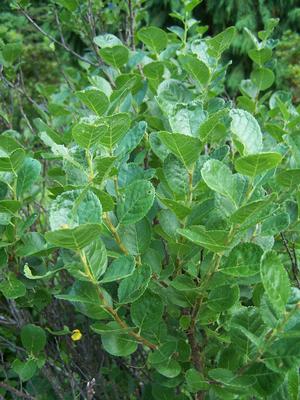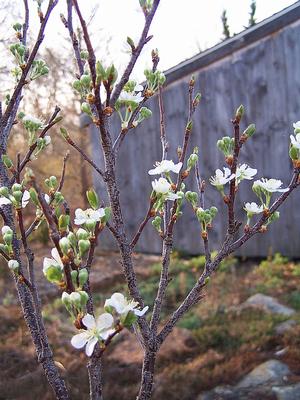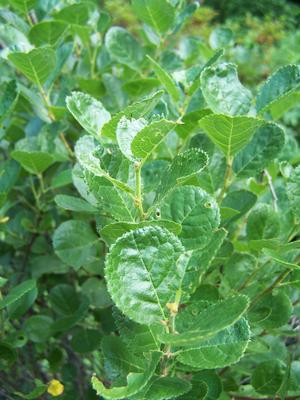
Note the rounded, scalloped leaf of the Graves Beach Plum

first time flowering on this very small shrub from cutting. As shrub grows the plethora of flowers will increase exponentially

a closer look at the unusual leaf form
Prunus maritima var. gravesii
Prunus maritima var. gravesii
Prunus maritima var. gravesii is genuinely a very rare endemic Beach Plum originally discovered in 1897. Growing in a graveled sand ridge overlooking Groton Long Point in Groton, Connecticut one individual sporting about 15 stems had been identified in this location, nowhere else. Sadly, though the USDA has listed it as threatened and endangered the Center for Plant Conservation lists the only individual ever found as now extinct. NatureServe in 2001 reported that this sole individual lived over 100 years after its initial discovery, eventually dying from natural causes at the turn to the 21st century.
Though its demise upon that scenic ridge at Groton Long Point indicates that no others of its kind exist in nature a thread of fortune has been bequeathed to the unique and exceedingly rare Grave's Beach Plum. Prunus maritima var. gravesii has been propagated at the New York Botanic Garden. Greg Anderson, associated with the University of Connecticut has surmised that only a handful of specimens remain in a few arboreta - possibly Connecticut College in New London and the Arnold Arboretum just west of Boston. There may yet be a specimen on the campus of the University of Connecticut, Storrs. Professor Anderson generously allowed us cuttings from a specimen to which he has access. Now we have it at Quackin' Grass. The numerical tally of specimens which may still be alive is unknown though it appears that they may be counted on fingers of one hand.
In good conditions this upright, multi-stemmed shrub may achieve 8.5 feet in height cloaked with rounded dark green glossy leaves with a crinkly texture and gently serrated edges. The rounded leaves of var. gravesii differ from the usual elliptic leaves found on all other Beach Plum. It produces white single and sometimes double flowers in May which draw all manner of bees and the occasional butterfly. Edible plums begin as small, green marbles and expand to the size of ping pong balls. By late summer the green sloes ripen crimson to purple. These may be harvested and turned into jelly or even wine at harvest. The plums are showy opulently decorating the autumn foliage tones that trend burgundy.
Prunus maritima var. gravesii has been surprisingly fussy from cuttings with some difficulty nurturing it through the first two years from the point of rooting. This may be due to the fact that we originally attempted cuttings from a very small individual that had not yet garnered its full strength and vigor. We retrieved several more cuttings this season which have rooted more readily. From cutting in a tube tray to gradually potting individuals into slightly larger pots finding the proper balance of drainage and water has also been somewhat vexing as var. gravesii appears to be slightly more fussy than other P. maritima we have grown. But as with other Beach Plums it gains zest and strength beyond those earliest most susceptible years in containers. We now have several individuals from which we can and will collect more cuttings. The addition of dolomitic limestone to potting media may very well be beneficial - consider the limey sandy soils in which Beach Plums revel.
One of the curious and complicating factors for the survival is that it requires pollen from another var. gravesii in order to produce fruit. Even though a single specimen carries both male and female flowers it may not pollinate itself. This is not a self-fertile plant similar to many Viburnum and Malus which require others in proximity for pollination resulting in fruit production. Though Graves Beach Plum may produce a few fruits without the benefit of cross pollination it will bless us with many fewer plums than it would if it was paired with another of its kind. Envisioned are multiple individuals planted in close enough proximity so that pollinators of many sorts might fly and flit from flower to flower, shrub to shrub gathering nectar from its pretty white flowers better insuring its cross pollination requirement.
But also implied in research is that var. gravesii cannot mingle with the straight P. maritima. This lends credence to some botanists and taxonomists that the morphology of Graves Beach Plum is distinct unto itself. If so, separate species status may be warranted. Unfortunately, for the apparent fact that var. gravesii shuns cross pollination from the common Beach Plum that single iconic individual at Groton Long Point that lived out its lonely life with no others of its kind in proximity was sadly marked for extinction.
Curious and curiouser: Graves Beach Plum appears to not produce true var. gravesii offspring from seed. For the fact that its offspring are quite variable and generally do not quite resemble the parent may mitigate the argument for distinct specie status. As is usual in the universe of plants there are many gray arenas and numerous exceptions which play upon an amazingly rich field. We humans, who are busy categorizing all manner of things are often stymied when the round peg refuses entry into that figurative square hole. Actual study and close scrutiny of the DNA of this rarity as compared to the average Beach Plum would answer questions concerning its place in the narrow hierarchy of the small group of Prunus maritima. However, if it were proven that Prunus maritima var. gravesii is a distinct and separate from P. maritima then it logically would be renamed Prunus gravesii. If so, its debut in this format would be more as a closely allied cousin to P. maritima rather than a sibling.
In a dream, the vision of which is a realistic possibility, I see conservationists, youth groups, the Conservation Commission in the Town of Groton and perhaps other shoreline communities, environmentalists, interested parties and Quackin' Grass Nursery in a collaborative effort. We work together in our various capacities to replant numerous individuals of Prunus maritima var. gravesii at Groton Long Point. I would like to see more shrubs acquired by all arboretums in the northeast region so that the viability of this unique plum steps slightly farther from the precipice upon which it teeters. I long for the interest of home gardeners with a bent towards nativity that they would procure Graves Beach Plum and assimilate individuals into their landscape schemes further buttressing the margin of its survival. No longer helpless and alone Graves Beach Plum as has occurred with the Ben Franklin Tree will find enough foothold to stave it from almost certain extinction.
Penned by Wayne Paquette, September 2017
The following article updates the information I originally penned regarding Prunus maritima var. gravesii. The authors are Matthew R. Klooster (Centre College), Bryan A. Connolly (ECSU), Emily M. Benedict (OSU and others), Lisa C. Grubisha (UW) and Gregory Anderson (UConn). It was Professor Anderson who allowed me to take cuttings from the specimen he has grown for many years at his home.
"Graves' Beach Plum (Prunus maritima var. gravesii) has been notable for its unique morphological form since a single individual was first discovered on Esker Point in Groton, Connecticut and formally described in 1897. This original clone is now extinct in the wild and is presently kept in cultivation on the University of Connecticut campus, with no additional wild plants discovered in 120 years. It was distinguished morphologically based primarily on its distinctive orbicular leaves, which differ from the ovate leaves found in P. maritima var. maritima. Prior studies have shown few morphological differences between P. maritima var. gravesii and P. maritima var. maritima and full reproductive compatibility has been experimentally observed between the two taxa. However, the few unique characteristics of P. maritima var. gravesii merit further investigation to determine if it has unique molecular differences relative to var. maritima that might lead to the prioritization of conservation and possible reintroduction efforts. Twelve polymorphic microsatellite markers were used to evaluate the genetic composition of 40 P. maritima var. maritima plants from three regional populations (Milford, Connecticut, Waterford, Connecticut, and Weekapaug, Rhode Island) and one additional individual from the type locality of P. maritima var. gravesii. High levels of allelic diversity and heterozygosity were observed among the forty-one samples. Additionally, low levels of genetic differentiation were observed among populations sampled, suggesting regular gene flow occurs among populations. Of the 12 loci studied, P. maritima var. gravesii possessed only one private allele existing in the heterozygotic condition, sharing all other alleles across loci with the P. maritima var. maritima samples. Further evaluations of genetic structure, including principal coordinates analysis and population assignment analysis, revealed the genotypic identity of P. maritima var. gravesii placed it within populations of P. maritima var. maritima and not as a discrete taxon. Therefore, we propose that the current variety classification be changed, and P. maritima var. gravesii should now be considered a naturally occurring but exceptionally rare morphological variant of the widespread P. maritima var. maritima, as P. maritima forma gravesii."